Welcome to our comprehensive guide on Rotala Manipurensis, a captivating aquatic plant that holds a mystique and allure all its own.
As passionate aquarists, we understand the excitement of discovering new species and the joy of creating thriving aquatic ecosystems.
With this care guide, we aim to shed light on Rotala Manipurensis, providing you with valuable insights into its origins, distinctive features, ideal cultivation conditions, propagation methods, and more.
Rotala Manipurensis, also known as the aquatic plant, is a stunning addition to any aquarium.
Its vibrant coloration and delicate foliage make it a sought-after choice for aquascaping enthusiasts.
However, to unlock the full potential of this enigmatic plant, one must understand its peculiar growth requirements and provide the necessary care.
Throughout this guide, we will take you on a journey through the world of Rotala Manipurensis, unraveling its secrets and equipping you with the knowledge to cultivate and maintain a thriving population of this captivating plant.
Whether you are a beginner or a seasoned aquarist, this guide will be your go-to resource for everything you need to know about Rotala Manipurensis.
Key Takeaway
- Rotala Manipurensis, an enigmatic aquatic plant, adds vibrancy and elegance to aquariums.
- Cultivating Rotala Manipurensis requires specific attention to its growth requirements.
- Understanding its origins, distinctive features, and ideal conditions is crucial for successful care.
- Propagation techniques and planting methods contribute to the growth and beauty of Rotala Manipurensis.
- Adequate lighting, pruning, and maintenance ensure the longevity and health of this aquatic plant.
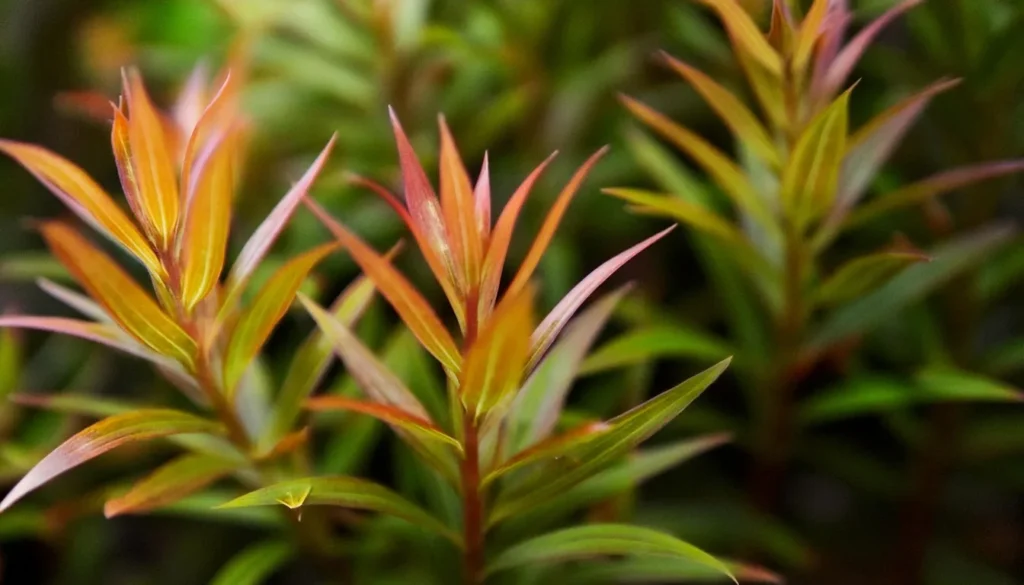
Quick Stats
| Attribute | Details |
| Family Name | Lythraceae |
| Common Name | Manipur Rotala |
| Origin | Manipur, India |
| Height | Approximately 15-30 cm (6-12 inches) |
| pH Range | 6.0 – 7.5 |
| CO2 Requirement | Moderate to High |
| Growth Rate | Moderate to Fast |
| Care Level | Moderate to Difficult |
| Color Form | Green, with potential for red hues under high light |
| Water Conditions | 22-28°C (72-82°F), soft to moderately hard water |
| Max Size | Typically remains small, with narrow leaves |
| Lighting | Moderate to High |
| Supplements | Requires nutrient-rich substrate and regular dosing of liquid fertilizers |
| Placement | Mid-ground to Background |
| Propagation | Easily propagated through stem cuttings or replanting trimmings |
What Is Rotala Manipurensis?
In this section, we will delve into the origins and distinctive features of Rotala Manipurensis, an enchanting aquatic plant that has captivated aquarium enthusiasts around the world.
Origins And Habitat
- Rotala Manipurensis is native to Manipur, a state located in northeastern India. The plant takes its name from the Manipur region, where it was first discovered in the wild. Manipur is known for its rich biodiversity and picturesque landscapes, providing the perfect habitat for Rotala Manipurensis to thrive.
- The plant is typically found growing submerged in slow-moving or stagnant water bodies such as rivers, ponds, and marshes. It is often found alongside other aquatic plants, forming beautiful underwater ecosystems.
Distinctive Features
- Rotala Manipurensis boasts several distinctive features that set it apart from other aquarium plants. Its narrow, lance-shaped leaves have vibrant green coloration that adds a refreshing touch to any aquatic environment.
- One of Rotala Manipurensis’s most striking characteristics is its growth pattern. The plant develops multiple upright stems that branch out with lush foliage, creating a dense and visually appealing appearance. This growth habit makes it an excellent choice for creating lush backgrounds or focal points in aquariums.
- Another noteworthy feature is the plant’s adaptability. Rotala Manipurensis can tolerate a wide range of water conditions, making it suitable for both beginner and experienced aquarium keepers. Its ability to thrive in diverse environments contributes to its popularity among aquarists worldwide.
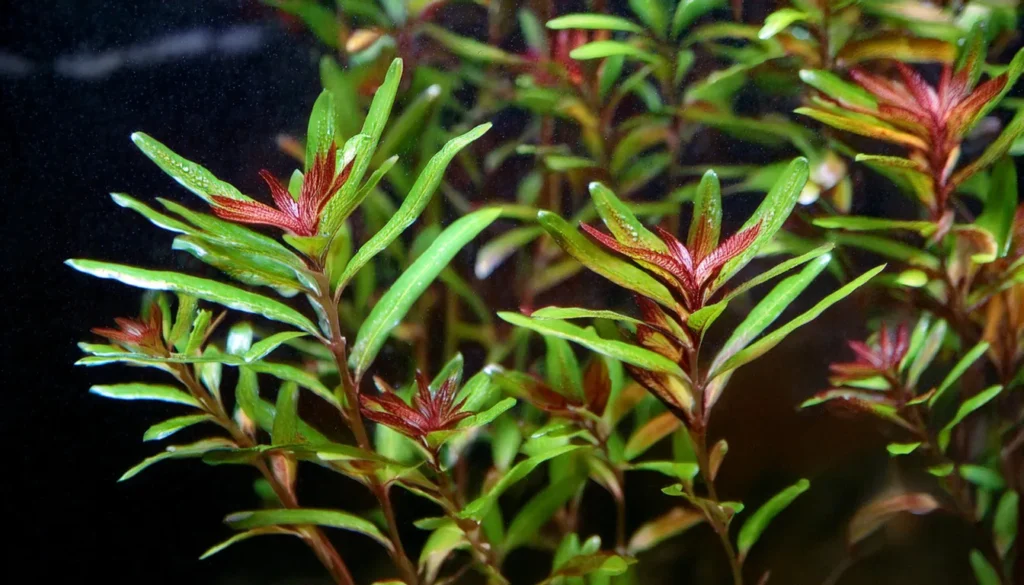
History Of Rotala Manipurensis
Rotala Manipurensis has a rich history that traces its origins and evolution within the aquarium hobby.
Understanding its historical context allows us to appreciate the significance and beauty of this aquatic plant. Let’s delve into the captivating story behind Rotala Manipurensis.
- Rotala Manipurensis was first discovered in the Manipur region of northeastern India, where it thrives in the wetlands and marshy areas. It was initially found growing along the banks of the Loktak Lake. The plant’s distinctive appearance and vibrant colors soon caught the attention of aquarists and collectors around the world.
- As the demand for unique and visually striking aquarium plants grew, Rotala Manipurensis gained popularity in the international aquarium trade. It garnered attention for its aesthetic appeal, moderate care requirements, and versatility in aquascaping.
- Over the years, Rotala Manipurensis has become a staple in the aquarist community. It is admired for its graceful presence and ability to enhance the visual impact of aquatic landscapes. Its striking red and green coloration and delicate foliage have captivated hobbyists and propelled the plant’s recognition and cultivation on a global scale.
- The history of Rotala Manipurensis is closely intertwined with the growth and evolution of the aquarium hobby. Its introduction into the market brought forth new possibilities for aquascaping and inspired aquarists to experiment with innovative designs.
- As Rotala Manipurensis’s popularity continues to rise, breeders and enthusiasts are constantly working to improve its form, color, and growth patterns. This ongoing commitment to refinement and innovation ensures that Rotala Manipurensis remains at the forefront of the aquarium hobby, captivating enthusiasts with its timeless beauty.
| Year | Significant Milestone |
| 1995 | Rotala Manipurensis discovered in the Manipur region of northeastern India |
| 1997 | Introduction of Rotala Manipurensis into the international aquarium trade |
| 2002 | Rotala Manipurensis gains popularity as a desirable aquascaping plant |
| 2010 | Breeders focus on improving form, color, and growth patterns |
Water Parameters
The water parameters play a significant role in the growth and overall health of Rotala Manipurensis.
You can promote optimal plant growth and vibrant foliage by ensuring the ideal water conditions.
- Temperature: Rotala Manipurensis thrives in temperatures between 75°F and 82°F (24°C – 28°C). Maintaining a consistent and suitable temperature range is essential for the plant’s well-being.
- pH: Aim for a slightly acidic to neutral pH level between 6.0 and 7.0. It is important to regularly monitor and adjust the pH to provide an environment conducive to Rotala Manipurensis’ growth.
- Hardness: The plant prefers moderately soft to slightly hard water, with a general hardness (GH) between 4 and 8 dGH. Keeping the water hardness within this range can support healthy growth.
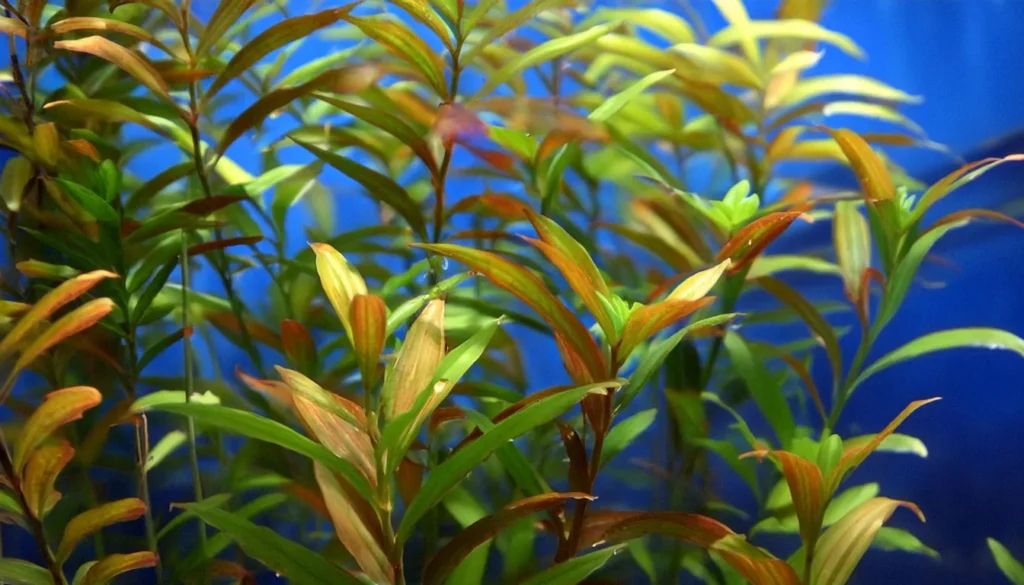
Optimal Temperature For Growth
- Metabolic Rate: Warmer temperatures within the specified range generally lead to increased metabolic rates in plants. This means that Rotala Manipurensis can carry out essential physiological functions more efficiently, promoting robust growth.
- Photosynthesis: Temperature affects the rate of photosynthesis in aquatic plants. Within the optimal range, Rotala Manipurensis can efficiently utilize light energy to convert carbon dioxide and water into oxygen and glucose, which fuels growth and development.
- Nutrient Uptake: Temperature influences nutrient uptake and assimilation in plants. Within the optimal range, Rotala Manipurensis can absorb essential nutrients from the water and substrate more effectively, supporting healthy growth and vibrant coloration.
- Disease Resistance: Maintaining the optimal temperature range helps bolster the plant’s immune system and resistance to diseases and pests. Extreme temperature fluctuations or prolonged exposure to temperatures outside the ideal range can weaken the plant and make it more susceptible to stressors.
RELATED: A Comprehensive Guide To Growing And Caring For Najas Indica
Lighting Needs
Rotala Manipurensis requires adequate light intensity and the right spectrum to thrive and exhibit its full range of colors. Here are some key factors to consider:
- Light Intensity: Rotala Manipurensis benefits from moderate to high light intensity. Insufficient light can lead to stunted growth and faded colors, while excessive light can cause algae problems. It is recommended to provide around 2-3 watts per gallon of aquarium water for optimal growth.
- Light Spectrum: The light spectrum is crucial in promoting colorful growth in Rotala Manipurensis. This plant responds well to a balanced spectrum, including both blue and red light wavelengths. Utilizing a full-spectrum LED light fixture or combining different lighting sources can help create the ideal spectrum for vibrant coloration.
Substrate And Fertilization
The choice of substrate and proper fertilization techniques are crucial elements in creating the ideal conditions for Rotala Manipurensis to thrive.
These factors provide the necessary nutrients for sustained growth and ensure the plant’s long-term health.
For the substrate:
- Choose a nutrient-rich substrate that provides a steady supply of essential nutrients for the plant.
- Ensure proper substrate depth to accommodate Rotala Manipurensis’ root system. A depth of 2-3 inches (5-8 cm) is generally recommended.
When it comes to fertilization:
- Consider using a comprehensive liquid fertilizer or root tabs to supplement the substrate’s nutrients.
- Follow the recommended dosage and frequency as indicated by the fertilizer manufacturer.
- Regularly monitor nutrient levels and adjust fertilization accordingly to prevent deficiencies or excesses that can impact plant health.
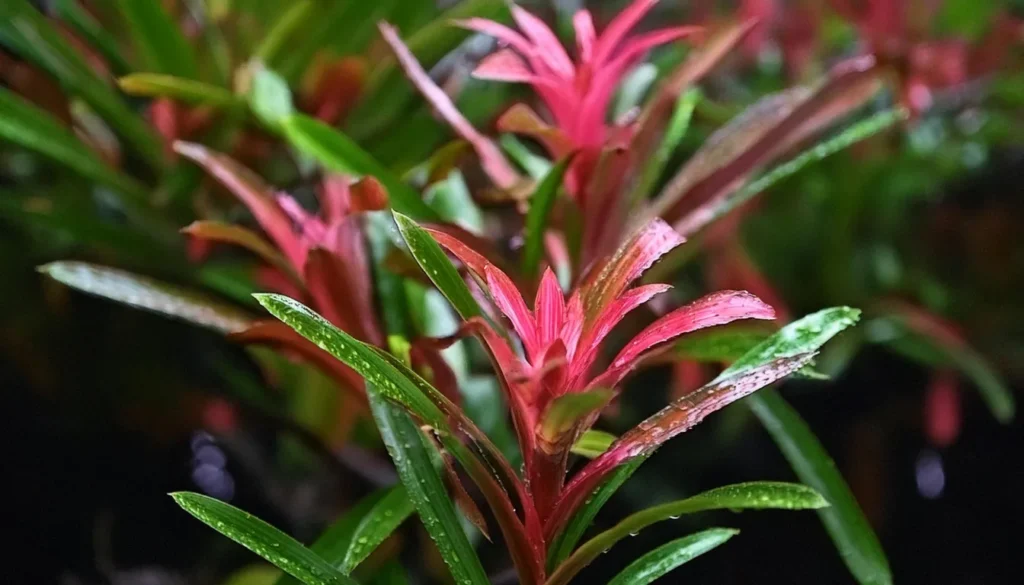
Placement Option
- Background Planting: Rotala Manipurensis can be placed in the background of your aquarium to create a lush green backdrop. Plant it behind shorter foreground plants or hardscape elements like rocks or driftwood. This placement helps to add depth and dimension to your aquascape.
- Midground Planting: If you have a larger aquarium, you can also use Rotala Manipurensis as a midground plant. Plant it in front of taller background plants but behind smaller foreground plants. This placement helps to fill in the middle section of the aquarium and adds visual interest.
- Group Planting: Plant several stems of Rotala Manipurensis together in clusters to create a dense, bushy effect. Group planting enhances the visual impact of the plant and can serve as a focal point in your aquascape.
- Foreground Accent: While Rotala Manipurensis is typically used in the background or midground, you can also use a few stems as a foreground accent. Plant individual stems or small clusters along the front of the aquarium to add texture and color to the foreground.
Recommended Tank Size
- Plant Size and Growth Rate: Rotala Manipurensis can grow relatively tall, with its stems reaching up to 12 inches (30 cm) or more under optimal conditions. Therefore, it’s essential to choose a tank size that provides enough vertical space for the plant to grow without crowding or overshadowing other plants.
- Aquascape Design: Consider the overall design and layout of your aquascape when selecting a tank size. Rotala Manipurensis can be used as a background, midground, or accent plant, depending on your preferences and the size of your tank. Choose a tank size that allows you to create the desired aesthetic and spatial arrangement.
- Fish and Livestock Compatibility: Take into account the fish and other livestock you plan to keep in the aquarium. Larger fish may require more swimming space, while smaller fish and invertebrates may thrive in smaller tanks. Ensure that the tank size accommodates the needs of both the plants and the animals.
- Maintenance and Care: Larger tanks generally offer more stability in terms of water parameters and are easier to maintain in the long run. However, smaller tanks can also be suitable for growing Rotala Manipurensis, especially if proper care and maintenance practices are followed.
- Personal Preferences: Ultimately, the ideal tank size for growing Rotala Manipurensis depends on your personal preferences, available space, and budget. Consider factors such as the size of the room where the aquarium will be located and the visual impact you want to achieve with your aquascape.
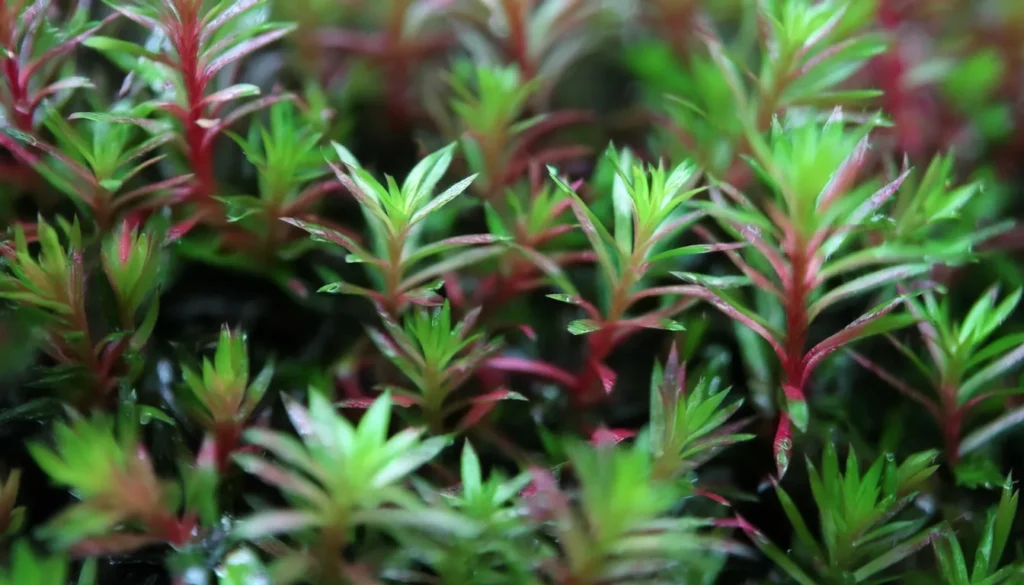
Compatible Aquatic Species
When choosing fish and other fauna to coexist with Rotala Manipurensis, it is important to consider their behavior, size, and water parameter preferences.
Here are some compatible species that can thrive alongside Rotala Manipurensis:
- Tetras (such as Neon Tetras, Cardinal Tetras, and Ember Tetras)
- Gouramis (such as Dwarf Gouramis and Honey Gouramis)
- Rasboras (such as Harlequin Rasboras and Chili Rasboras)
- Otocinclus Catfish
- Amano Shrimp
| Compatible Fish Species | Compatibility Level |
| Neon Tetras | High |
| Cardinal Tetras | High |
| Ember Tetras | High |
| Dwarf Gouramis | Moderate |
| Honey Gouramis | Moderate |
| Harlequin Rasboras | High |
| Chili Rasboras | High |
| Otocinclus Catfish | High |
| Amano Shrimp | Moderate |
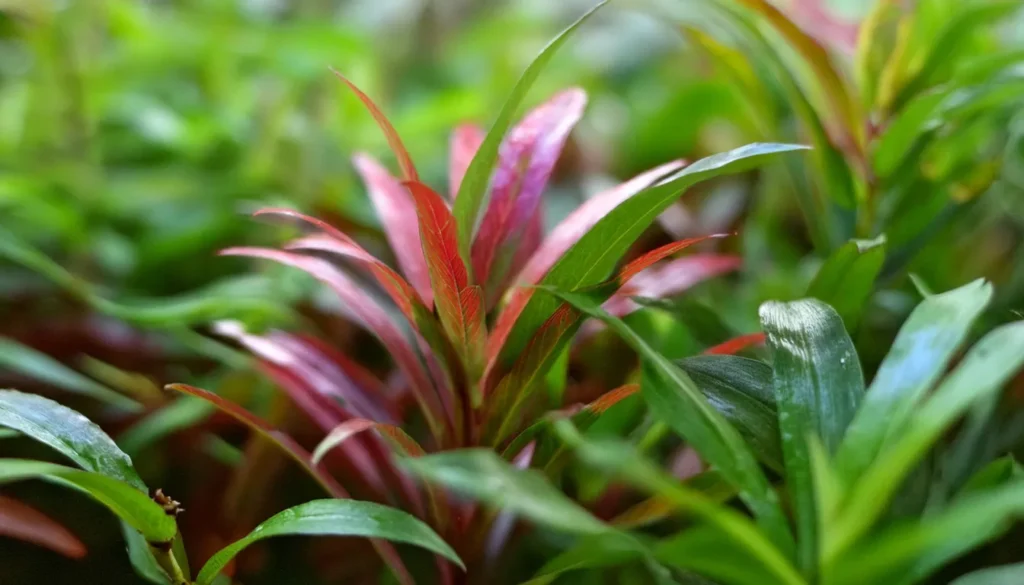
Nutritional Needs Of The Plant
To understand the nutritional needs of Rotala Manipurensis, it’s helpful to break down the essential elements required for its growth and development.
Like all aquatic plants, Rotala Manipurensis relies on a combination of macronutrients, micronutrients, and other factors to thrive.
Here are the key nutritional needs of Rotala Manipurensis:
Macronutrients
- Nitrogen (N): Nitrogen is a vital component of chlorophyll, the pigment responsible for photosynthesis. Rotala Manipurensis requires nitrogen for overall growth and development. It can be absorbed from nitrates (NO3-) and ammonium (NH4+).
- Phosphorus (P): Phosphorus is essential for energy transfer within the plant, particularly in processes like photosynthesis and cell division. It plays a crucial role in root development and overall plant growth.
- Potassium (K): Potassium is involved in various physiological processes, including enzyme activation, osmoregulation, and stomatal regulation. It contributes to overall plant health, growth, and resistance to stress.
Secondary Nutrients
- Calcium (Ca): Calcium is necessary for cell wall structure and stability. It also plays a role in root development and nutrient uptake.
- Magnesium (Mg): Magnesium is a central component of chlorophyll molecules and is crucial for photosynthesis. It’s essential for energy transfer and enzyme activation within the plant.
Micronutrients (Trace Elements)
- Iron (Fe): Iron is essential for chlorophyll synthesis and is involved in electron transport during photosynthesis. Iron deficiency can lead to chlorosis (yellowing of leaves).
- Manganese (Mn), Zinc (Zn), Copper (Cu), Boron (B), Molybdenum (Mo), and Chlorine (Cl): These micronutrients are required in smaller quantities but are essential for various metabolic processes within the plant, including enzyme activation and hormone synthesis.
Rotala Manipurensis Cultivation Tips
- Nutrient Supplementation: Provide liquid fertilizers or dry fertilizers containing macro and micronutrients essential for plant growth. Ensure a balanced nutrient regimen to prevent deficiencies and promote healthy growth. Pay attention to the requirements of Rotala Manipurensis for nitrogen, phosphorus, potassium, and micronutrients.
- Water Parameters: Maintain stable and optimal water parameters for Rotala Manipurensis. It generally thrives in slightly acidic to neutral water with a pH range of 6.0 to 7.5. Water temperature should be kept between 72°F to 82°F (22°C to 28°C).
- Pruning: Regularly prune Rotala Manipurensis to promote bushy growth and prevent the plant from becoming leggy. Trim the stems back to encourage lateral growth and replant the trimmings to propagate new plants.
- Propagation: Rotala Manipurensis can be propagated through stem cuttings. Simply cut a healthy stem with sharp scissors and replant the cutting into the substrate. Ensure that each cutting has several leaves for optimal growth.
- Water Flow: Provide moderate water flow in the aquarium to ensure nutrient distribution and prevent the accumulation of debris around the plants. However, avoid strong currents that may uproot the plants or damage delicate stems.
Plant Propagation Tips
- Select Healthy Stems: Choose stems that are healthy and free from any signs of disease or damage. Healthy stems will have vibrant green leaves and firm, sturdy stems.
- Prepare Equipment: Use sharp, clean scissors or aquascaping tools to make clean cuts. Dirty or dull tools can damage the plant and increase the risk of infection.
- Take Cuttings: Using your scissors, cut a portion of the stem just below a node (where leaves are attached). Each cutting should be around 2 to 4 inches (5 to 10 cm) long, with several leaves attached.
- Trim Leaves: Remove any leaves from the bottom portion of the cutting that will be planted in the substrate. Leaving a few leaves at the top of the cutting will help the plant continue photosynthesis while it roots.
- Plant Cuttings: Insert the cuttings into the substrate, making sure to bury the bottom portion of the stem securely. Plant them at an angle to encourage new growth and prevent them from floating away.
- Provide Optimal Conditions: Maintain stable water parameters, adequate lighting, and nutrient levels to support root development and new growth. Ensure proper circulation and gentle water flow around the cuttings.
Benefits Of Planting Rotala Manipurensis
- Water Filtration: Like all aquatic plants, Rotala Manipurensis helps to naturally filter the water in your aquarium by absorbing nutrients, such as nitrates and phosphates, that can contribute to algae growth. This can help to maintain water quality and clarity, creating a healthier environment for your fish and other aquatic inhabitants.
- Oxygenation: During photosynthesis, Rotala Manipurensis absorbs carbon dioxide and releases oxygen into the water. This process helps to oxygenate the aquarium, providing vital respiratory support for fish, shrimp, and other aquatic organisms.
- Algae Control: By competing with algae for nutrients and light, Rotala Manipurensis can help to inhibit the growth of unwanted algae in your aquarium. The dense growth of Rotala Manipurensis can shade the substrate and create competition for resources, reducing the likelihood of algae outbreaks.
- Aquascape Enhancement: Rotala Manipurensis adds visual interest and texture to your aquascape with its delicate, branching stems and vibrant green foliage. It can be used to create lush background plantings, fill in empty spaces, or add depth and dimension to your underwater landscape.
- Habitat and Shelter: The dense growth of Rotala Manipurensis provides habitat and shelter for fish, shrimp, and other aquatic creatures. It offers refuge for shy or breeding fish, as well as a grazing surface for algae-eating species.
RELATED: A Complete Handbook For Myriophyllum Guyana Cultivation And Maintenance
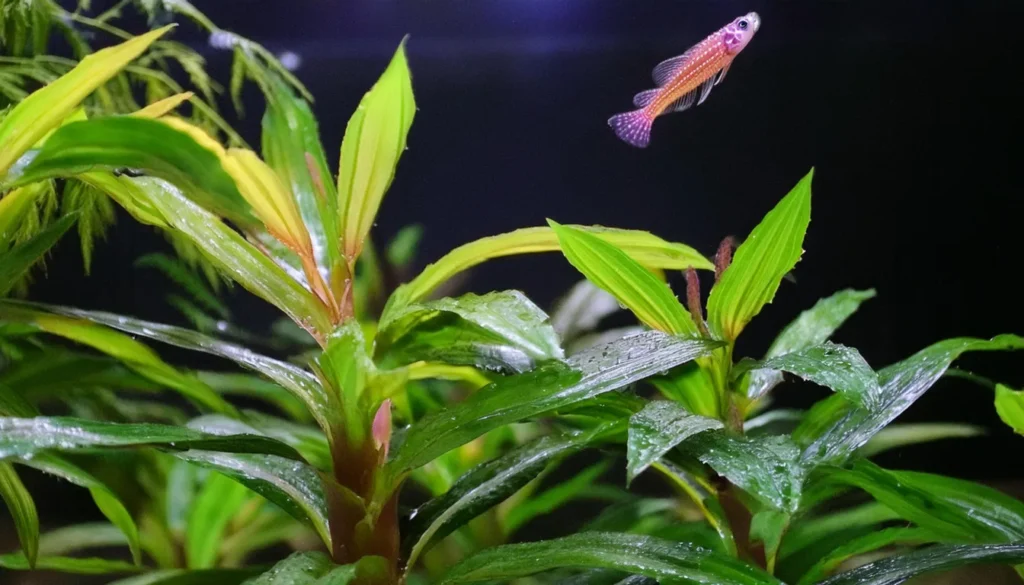
Common Issues In Plant Health And How to Address Them
While this plant is generally a hardy plant, it can encounter a few common issues that need to be addressed promptly to maintain its health and vitality.
The following table outlines some common issues in plant health and their corresponding solutions:
| Issue | Solution |
| Pale or yellowing leaves | Check water parameters and adjust as necessary. Ensure adequate lighting and provide appropriate fertilization. |
| Stunted growth | Optimize water conditions, including temperature, pH, and hardness. Ensure sufficient nutrient availability through substrate and fertilization. |
| Algae overgrowth | Maintain proper water circulation, adjust lighting intensity, and duration. Implement regular water changes and consider adding algae-eating critters. |
Conclusion
Throughout this comprehensive guide, we have explored the enigmatic beauty of Rotala Manipurensis and its significance in the world of aquarium plants.
From its origins and distinctive features to the ideal cultivation conditions and propagation methods, we have covered many topics to help you understand and care for this captivating aquatic plant.
By providing insights into the history of Rotala Manipurensis and sharing tips on planting techniques, lighting needs, pruning, and maintenance, we have equipped you with the knowledge and tools necessary to create vibrant displays and nurture the growth of these plants.
We have also highlighted the importance of selecting compatible aquatic species and managing water quality to ensure the well-being of your tank inhabitants.
Frequently Asked Questions
What Are The Lighting Needs Of Rotala Manipurensis?
It requires moderate to high light intensity and a full spectrum of light for proper photosynthesis.
Using quality aquarium lighting and providing the right balance of light spectrum will promote healthy growth and vibrant coloration in the plants.
How Should Rotala Manipurensis Be Maintained And Pruned?
Regular pruning is necessary to maintain the shape and health of Rotala Manipurensis.
Trimming techniques, such as cutting the stem above a leaf node, promote fuller bushes. Pruning should be done with sharp, clean tools to prevent damage to the plant.
What Are The Maintenance And Care Requirements For Rotala Manipurensis?
In addition to regular pruning, it requires a nutrient-rich substrate and regular fertilization.
Proper water parameters must be maintained, and attention should be given to preventing and managing algae growth, which can affect the plant’s health.
What Fish And Aquatic Species Are Compatible With Rotala Manipurensis?
This plant can coexist harmoniously with a variety of fish and aquatic species.
It is compatible with most peaceful and community fish that do not uproot or disturb the plants.
The plant can also provide hiding places and grazing surfaces for small invertebrates and fry.
What Advanced Aquascaping Techniques Can Be Used With Rotala Manipurensis?
This plant can be used to create stunning underwater landscapes.
It can be incorporated into various layout styles, such as Dutch, Iwagumi, or Nature Aquarium.
With careful planning and design, aquarists can create artistic and visually striking aquascapes using this captivating plant.
- Unveiling The Wonders Of Riccia Fluitans In Aquascapes - August 7, 2024
- Vallisneria Gigantea Var. Guide To Care And Cultivation At Home - July 31, 2024
- Vesicularia Dubyana Care & Growth Guide Tips For Beginner Gardeners - July 30, 2024
